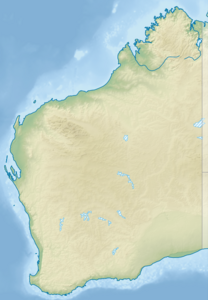Pigeon Island (Houtman-Abrolhos)
| Pigeon Island | ||
|---|---|---|
| Waters | Indian Ocean | |
| Archipelago | Houtman Abrolhos | |
| Geographical location | 28 ° 27 ′ S , 113 ° 44 ′ E | |
|
|
||
| length | 0.43 | |
| width | 0.14 | |
| surface | 4.3 ha | |
| Highest elevation | 3 m | |
Pigeon Iceland is a small island in the middle of Wallabi Group of the archipelago Houtman Abrolhos , an archipelago off the coast of Western Australia . It is almost completely left to fishermen who fish for Australian lobsters there and who have set up camp on the island. For this reason, the island is strongly shaped by humans and hardly left in its natural state like other islands in the archipelago. A nearby island that is also seasonally populated by fishermen is called Little Pigeon Island ; therefore, Pigeon Island is often referred to as the Big Pigeon Island .
history
Due to the location, it is believed that survivors of the shipwreck of the Batavia of 1629 reached the island. But there is no evidence for this. Guano was mined on the island in the 20th century .
geography
Pigeon Island is roughly triangular in shape with a short side in the southwest and two long sides converging in the northeast.
The island is covered by paths and huts: there are a total of 54 camps, a school and a pub as well as about 20 jetties along the northwest side, as the island can only be approached from this side. The island is surrounded by a reef to the south and east , but one passage, Pigeon Island Anchorage , extends along the northwest.
geology
The substrate of Pigeon Iceland consists of Wallabi Limestone , a dense, naturally cemented (Caliche) coral - limestone , which forms a thick platform carrying the Wallabi Group. This platform, which rises very abruptly from a flat shelf , is about 40 meters thick and originates from the Quaternary . Reefs that formed during the Eem warm period around 125,000 years ago when sea levels were higher than today now form the base of the "Central Platform" islands, to which Pigeon Island belongs.
flora
71 plant species have been counted on Pigeon Island, 45 of which are indigenous and 29 are naturalized :
fauna
Native animals include the rare spiny-tailed skink , the quail Turnix varius scintillans (Abrolhos painted button-quail) and the bush pigeon . House rats (Rattus rattus) used to be present, but have now been wiped out.
Human use
The Houtman Abrolhos Islands are completely under the control of Western Australia's Minister for Fisheries for the "Conservation of Flora and Fauna, Tourism, and for Purposes Associated with the Fishing" Industry). Pigeon Island is one of the few islands that is almost completely open to fishing. Due to the guano mining and the development of the fishing infrastructure, the island is hardly worthy of protection.
See also
Individual evidence
- ↑ Lindsay B. Collins, Zhu Zhong Rong, Karl-Heinz Wyrwoll: Late Tertiary-Quaternary Geological Evolution of the Houtman Abrolhos Carbonate Platforms, Northern Perth Basin. In: R. Purcell, P. Purcell (eds.): The sedimentary basins of Western Australia. vol. 2, Petroleum Exploration Society of Australia, Perth , Western Australia 1998: 647-663.
- ^ Lindsay B. Collins, Zhu Zhong Rong, Karl-Heinz Wyrwoll: Geology of the Houtman Abrolhos Islands. In: Leonard Vacher, Terrence Quinn (ed.): Geology and hydrogeology of carbonate islands (Developments in Sedimentology 54). Elsevier Science 2004: 811-834.
- ↑ JM Harvey, JJ Alford, VM Longman, GJ Keighery: A flora and vegetation survey of the Houtman Abrolhos, Western Australia. In: CALMScience. 2001, vol. 3, 4: 521-623.
- ^ Inventory of the Land Conservation Values of the Houtman Abrolhos Islands. October 2003 In: Fisheries Management Paper No. 151, Department of Fisheries, Government of Western Australia ISSN 0819-4327
- ^ AA Burbidge: Introduced mammals on Western Australian islands: Improving Australia's ability to protect its island habitats from feral animals. Final report for the Australian Government Department of the Environment and Heritage, Department of Conservation and Land Management, Government of Western Australia 2004.
- ↑ Management of the Houtman Abrolhos System: A Draft Review 2007-2017. Fisheries Management Paper No. 220, 2007. Department of Fisheries, Government of Western Australia.

